Comprehensive Review of Theories, Principles & Models in Education
VerifiedAdded on 2023/06/15
|15
|3433
|170
Essay
AI Summary
This essay provides a detailed overview of various theories, principles, and models used in education and training. It begins by examining constructivism and humanism theories, alongside behaviorism and cognitivism models, emphasizing their application in teaching, learning, and assessment. The essay further explores learning preferences, including Honey and Mumford's model, Kolb's experiential learning theory, and Fleming's VARK learning styles. It delves into assessment theories such as criterion referencing, ipsative referencing, norm referencing, and the CADET framework. The CIPP model is discussed as a framework for project conception, design, implementation, and assessment, alongside the theories of Tyler, Stenhouse, and Dewey. The essay concludes by evaluating reflection models, including the Kirkpatrick and Stufflebeam models, and Gibbs' and Brookfield's reflective cycles, highlighting their importance in improving communication and professional development.
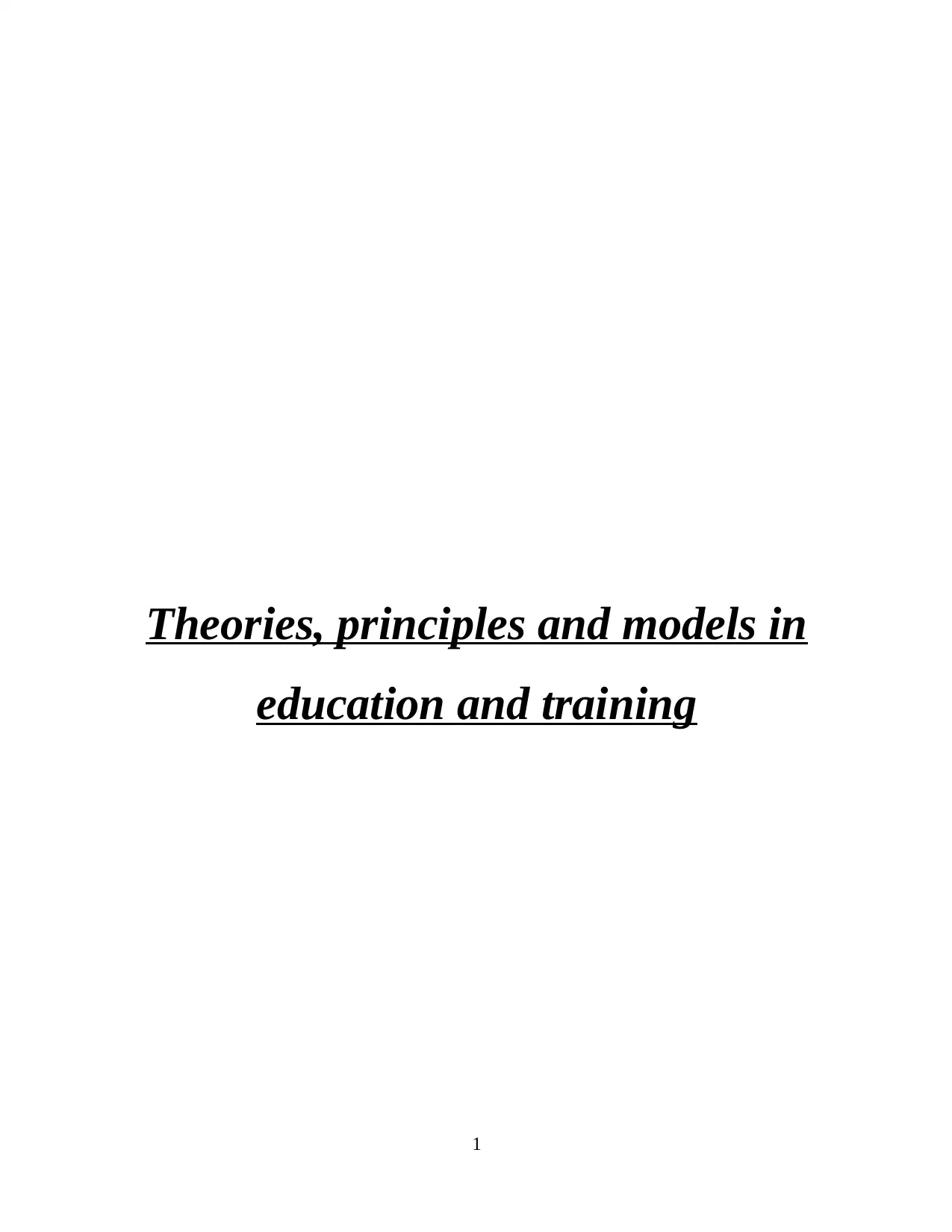
Theories, principles and models in
education and training
1
education and training
1
Paraphrase This Document
Need a fresh take? Get an instant paraphrase of this document with our AI Paraphraser
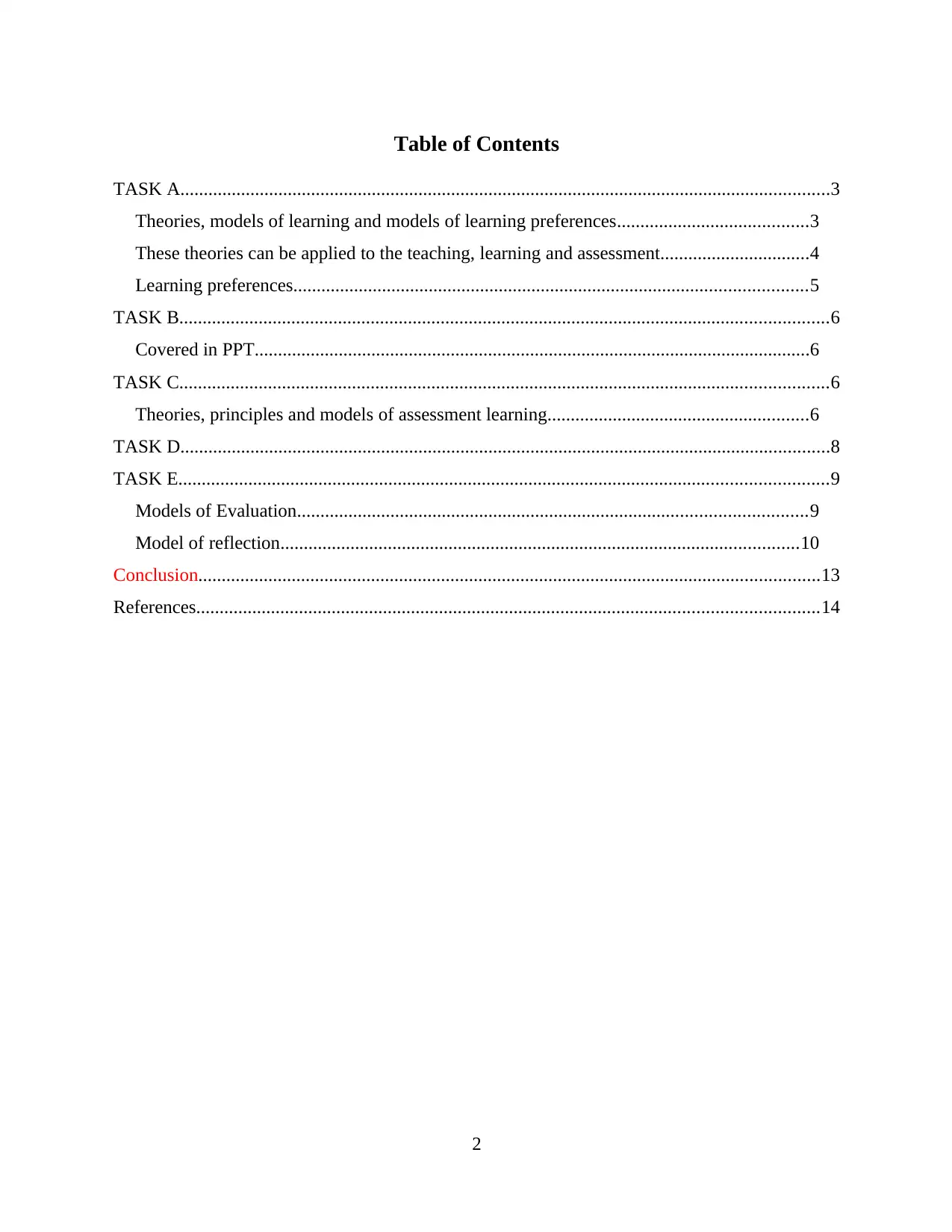
Table of Contents
TASK A...........................................................................................................................................3
Theories, models of learning and models of learning preferences.........................................3
These theories can be applied to the teaching, learning and assessment................................4
Learning preferences..............................................................................................................5
TASK B...........................................................................................................................................6
Covered in PPT.......................................................................................................................6
TASK C...........................................................................................................................................6
Theories, principles and models of assessment learning........................................................6
TASK D...........................................................................................................................................8
TASK E...........................................................................................................................................9
Models of Evaluation.............................................................................................................9
Model of reflection...............................................................................................................10
Conclusion.....................................................................................................................................13
References.....................................................................................................................................14
2
TASK A...........................................................................................................................................3
Theories, models of learning and models of learning preferences.........................................3
These theories can be applied to the teaching, learning and assessment................................4
Learning preferences..............................................................................................................5
TASK B...........................................................................................................................................6
Covered in PPT.......................................................................................................................6
TASK C...........................................................................................................................................6
Theories, principles and models of assessment learning........................................................6
TASK D...........................................................................................................................................8
TASK E...........................................................................................................................................9
Models of Evaluation.............................................................................................................9
Model of reflection...............................................................................................................10
Conclusion.....................................................................................................................................13
References.....................................................................................................................................14
2
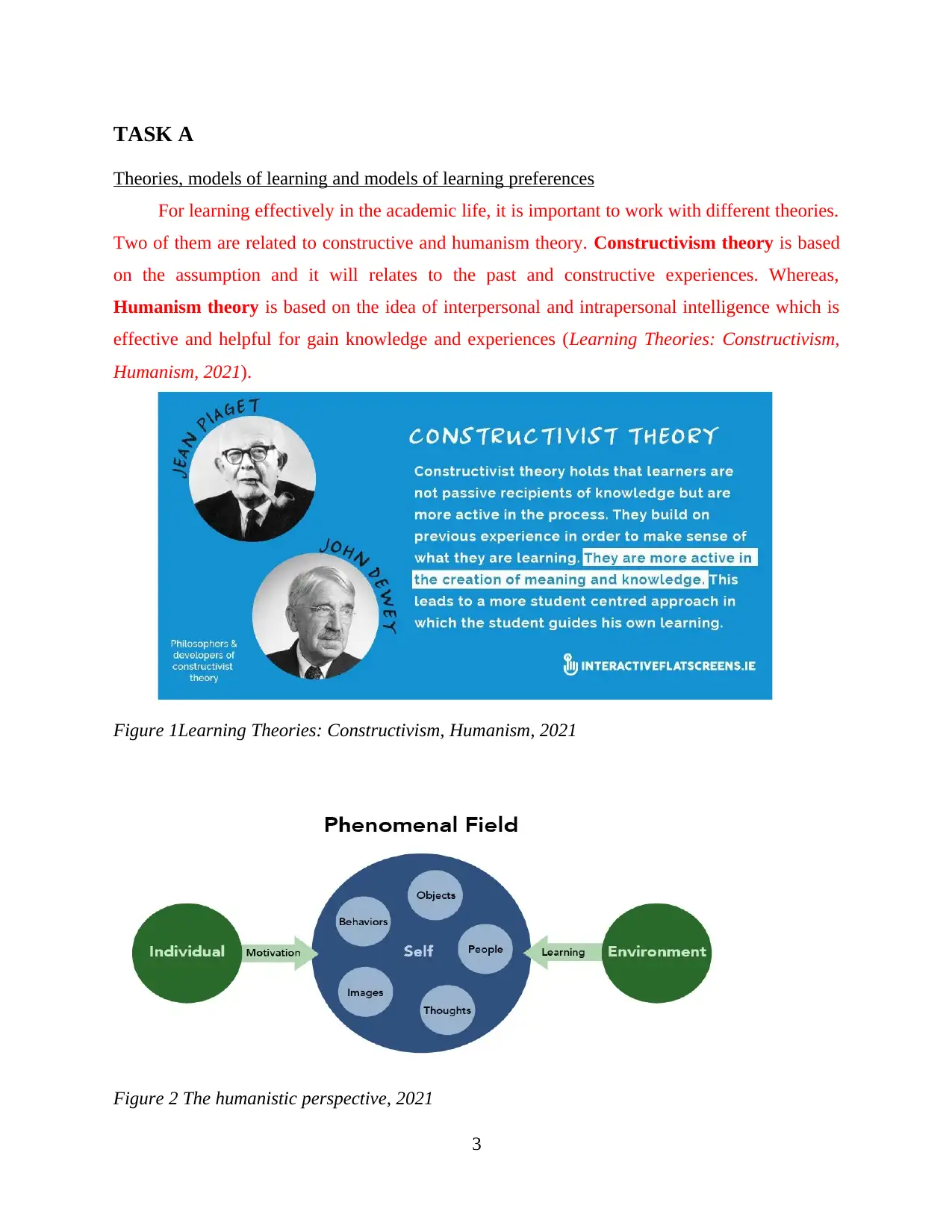
TASK A
Theories, models of learning and models of learning preferences
For learning effectively in the academic life, it is important to work with different theories.
Two of them are related to constructive and humanism theory. Constructivism theory is based
on the assumption and it will relates to the past and constructive experiences. Whereas,
Humanism theory is based on the idea of interpersonal and intrapersonal intelligence which is
effective and helpful for gain knowledge and experiences (Learning Theories: Constructivism,
Humanism, 2021).
Figure 1Learning Theories: Constructivism, Humanism, 2021
Figure 2 The humanistic perspective, 2021
3
Theories, models of learning and models of learning preferences
For learning effectively in the academic life, it is important to work with different theories.
Two of them are related to constructive and humanism theory. Constructivism theory is based
on the assumption and it will relates to the past and constructive experiences. Whereas,
Humanism theory is based on the idea of interpersonal and intrapersonal intelligence which is
effective and helpful for gain knowledge and experiences (Learning Theories: Constructivism,
Humanism, 2021).
Figure 1Learning Theories: Constructivism, Humanism, 2021
Figure 2 The humanistic perspective, 2021
3
⊘ This is a preview!⊘
Do you want full access?
Subscribe today to unlock all pages.

Trusted by 1+ million students worldwide
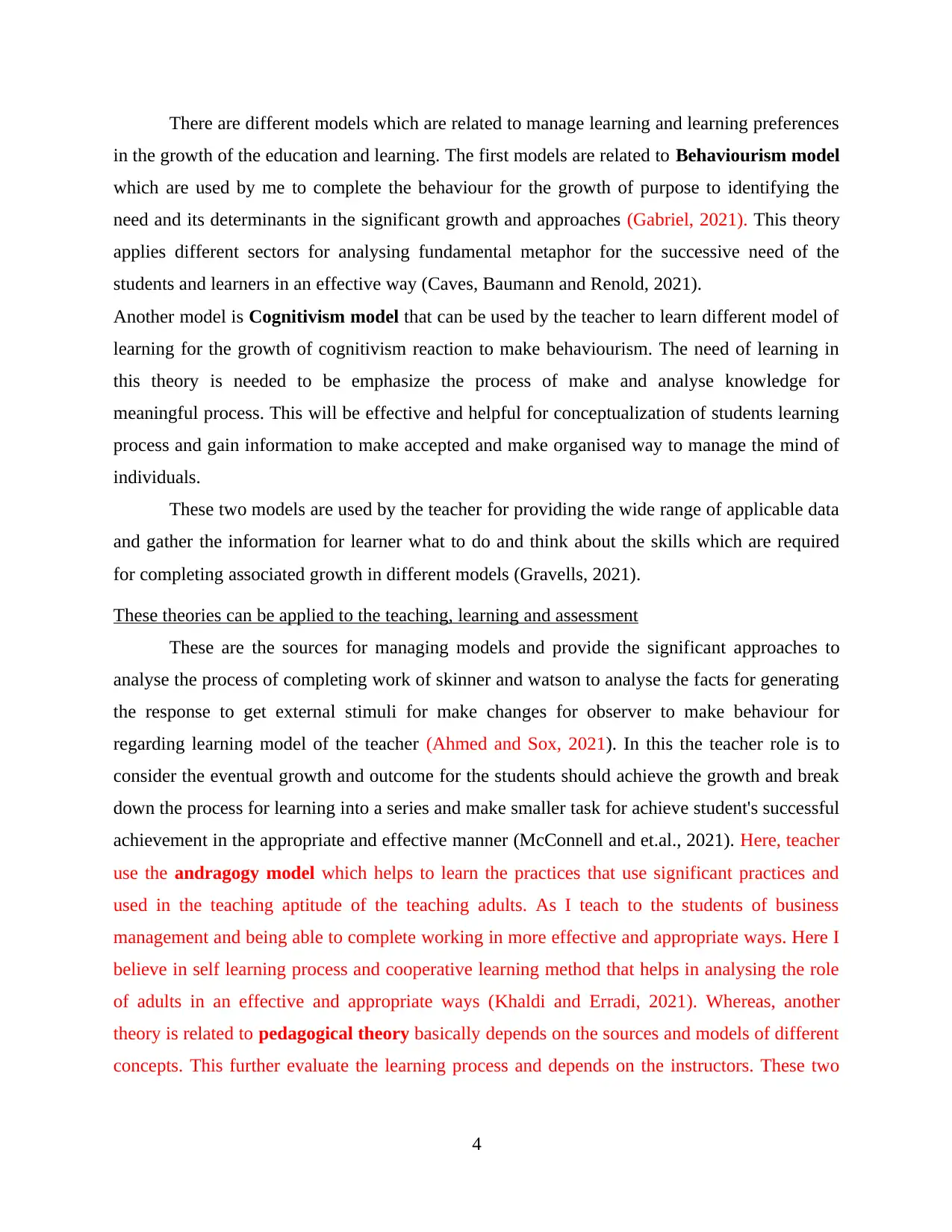
There are different models which are related to manage learning and learning preferences
in the growth of the education and learning. The first models are related to Behaviourism model
which are used by me to complete the behaviour for the growth of purpose to identifying the
need and its determinants in the significant growth and approaches (Gabriel, 2021). This theory
applies different sectors for analysing fundamental metaphor for the successive need of the
students and learners in an effective way (Caves, Baumann and Renold, 2021).
Another model is Cognitivism model that can be used by the teacher to learn different model of
learning for the growth of cognitivism reaction to make behaviourism. The need of learning in
this theory is needed to be emphasize the process of make and analyse knowledge for
meaningful process. This will be effective and helpful for conceptualization of students learning
process and gain information to make accepted and make organised way to manage the mind of
individuals.
These two models are used by the teacher for providing the wide range of applicable data
and gather the information for learner what to do and think about the skills which are required
for completing associated growth in different models (Gravells, 2021).
These theories can be applied to the teaching, learning and assessment
These are the sources for managing models and provide the significant approaches to
analyse the process of completing work of skinner and watson to analyse the facts for generating
the response to get external stimuli for make changes for observer to make behaviour for
regarding learning model of the teacher (Ahmed and Sox, 2021). In this the teacher role is to
consider the eventual growth and outcome for the students should achieve the growth and break
down the process for learning into a series and make smaller task for achieve student's successful
achievement in the appropriate and effective manner (McConnell and et.al., 2021). Here, teacher
use the andragogy model which helps to learn the practices that use significant practices and
used in the teaching aptitude of the teaching adults. As I teach to the students of business
management and being able to complete working in more effective and appropriate ways. Here I
believe in self learning process and cooperative learning method that helps in analysing the role
of adults in an effective and appropriate ways (Khaldi and Erradi, 2021). Whereas, another
theory is related to pedagogical theory basically depends on the sources and models of different
concepts. This further evaluate the learning process and depends on the instructors. These two
4
in the growth of the education and learning. The first models are related to Behaviourism model
which are used by me to complete the behaviour for the growth of purpose to identifying the
need and its determinants in the significant growth and approaches (Gabriel, 2021). This theory
applies different sectors for analysing fundamental metaphor for the successive need of the
students and learners in an effective way (Caves, Baumann and Renold, 2021).
Another model is Cognitivism model that can be used by the teacher to learn different model of
learning for the growth of cognitivism reaction to make behaviourism. The need of learning in
this theory is needed to be emphasize the process of make and analyse knowledge for
meaningful process. This will be effective and helpful for conceptualization of students learning
process and gain information to make accepted and make organised way to manage the mind of
individuals.
These two models are used by the teacher for providing the wide range of applicable data
and gather the information for learner what to do and think about the skills which are required
for completing associated growth in different models (Gravells, 2021).
These theories can be applied to the teaching, learning and assessment
These are the sources for managing models and provide the significant approaches to
analyse the process of completing work of skinner and watson to analyse the facts for generating
the response to get external stimuli for make changes for observer to make behaviour for
regarding learning model of the teacher (Ahmed and Sox, 2021). In this the teacher role is to
consider the eventual growth and outcome for the students should achieve the growth and break
down the process for learning into a series and make smaller task for achieve student's successful
achievement in the appropriate and effective manner (McConnell and et.al., 2021). Here, teacher
use the andragogy model which helps to learn the practices that use significant practices and
used in the teaching aptitude of the teaching adults. As I teach to the students of business
management and being able to complete working in more effective and appropriate ways. Here I
believe in self learning process and cooperative learning method that helps in analysing the role
of adults in an effective and appropriate ways (Khaldi and Erradi, 2021). Whereas, another
theory is related to pedagogical theory basically depends on the sources and models of different
concepts. This further evaluate the learning process and depends on the instructors. These two
4
Paraphrase This Document
Need a fresh take? Get an instant paraphrase of this document with our AI Paraphraser
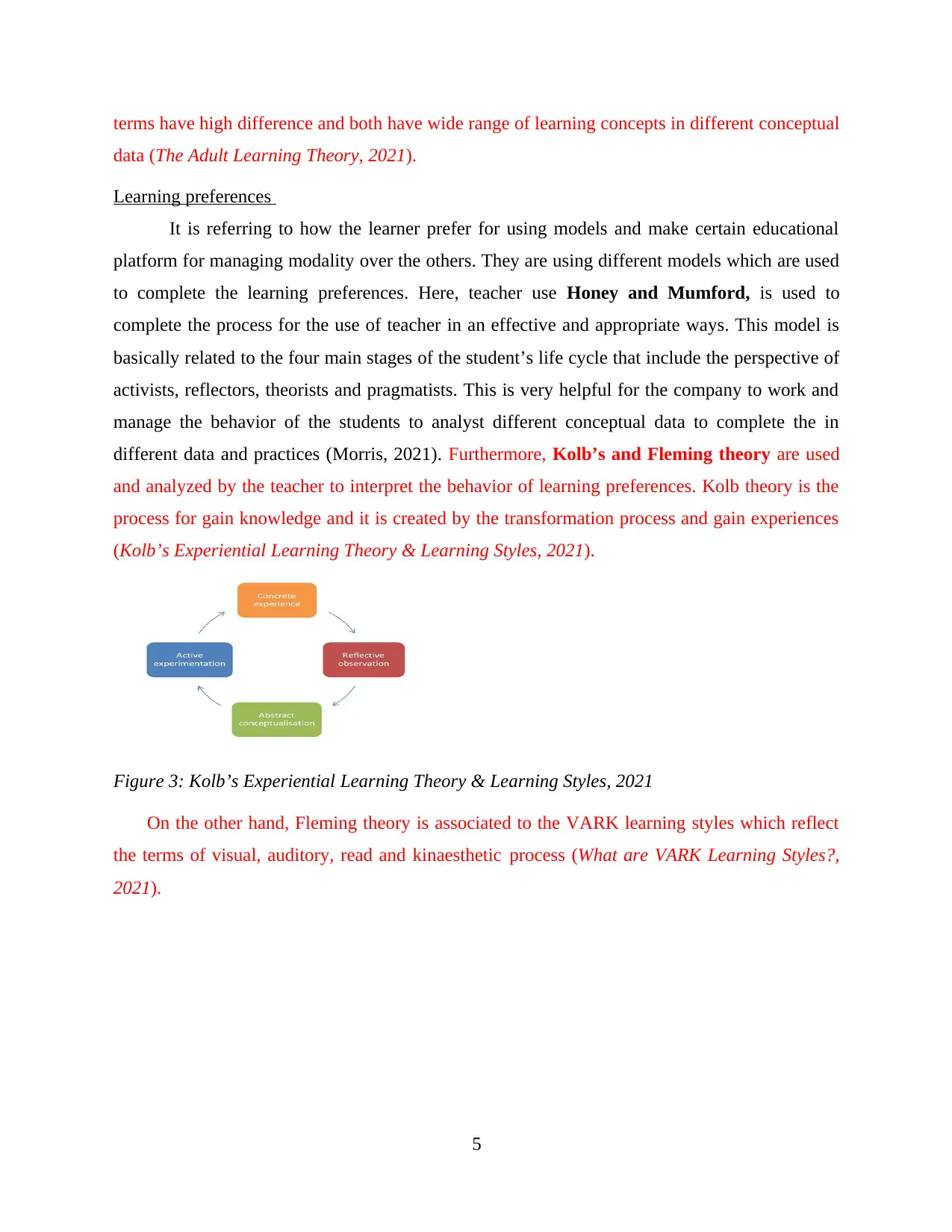
terms have high difference and both have wide range of learning concepts in different conceptual
data (The Adult Learning Theory, 2021).
Learning preferences
It is referring to how the learner prefer for using models and make certain educational
platform for managing modality over the others. They are using different models which are used
to complete the learning preferences. Here, teacher use Honey and Mumford, is used to
complete the process for the use of teacher in an effective and appropriate ways. This model is
basically related to the four main stages of the student’s life cycle that include the perspective of
activists, reflectors, theorists and pragmatists. This is very helpful for the company to work and
manage the behavior of the students to analyst different conceptual data to complete the in
different data and practices (Morris, 2021). Furthermore, Kolb’s and Fleming theory are used
and analyzed by the teacher to interpret the behavior of learning preferences. Kolb theory is the
process for gain knowledge and it is created by the transformation process and gain experiences
(Kolb’s Experiential Learning Theory & Learning Styles, 2021).
Figure 3: Kolb’s Experiential Learning Theory & Learning Styles, 2021
On the other hand, Fleming theory is associated to the VARK learning styles which reflect
the terms of visual, auditory, read and kinaesthetic process (What are VARK Learning Styles?,
2021).
5
data (The Adult Learning Theory, 2021).
Learning preferences
It is referring to how the learner prefer for using models and make certain educational
platform for managing modality over the others. They are using different models which are used
to complete the learning preferences. Here, teacher use Honey and Mumford, is used to
complete the process for the use of teacher in an effective and appropriate ways. This model is
basically related to the four main stages of the student’s life cycle that include the perspective of
activists, reflectors, theorists and pragmatists. This is very helpful for the company to work and
manage the behavior of the students to analyst different conceptual data to complete the in
different data and practices (Morris, 2021). Furthermore, Kolb’s and Fleming theory are used
and analyzed by the teacher to interpret the behavior of learning preferences. Kolb theory is the
process for gain knowledge and it is created by the transformation process and gain experiences
(Kolb’s Experiential Learning Theory & Learning Styles, 2021).
Figure 3: Kolb’s Experiential Learning Theory & Learning Styles, 2021
On the other hand, Fleming theory is associated to the VARK learning styles which reflect
the terms of visual, auditory, read and kinaesthetic process (What are VARK Learning Styles?,
2021).
5
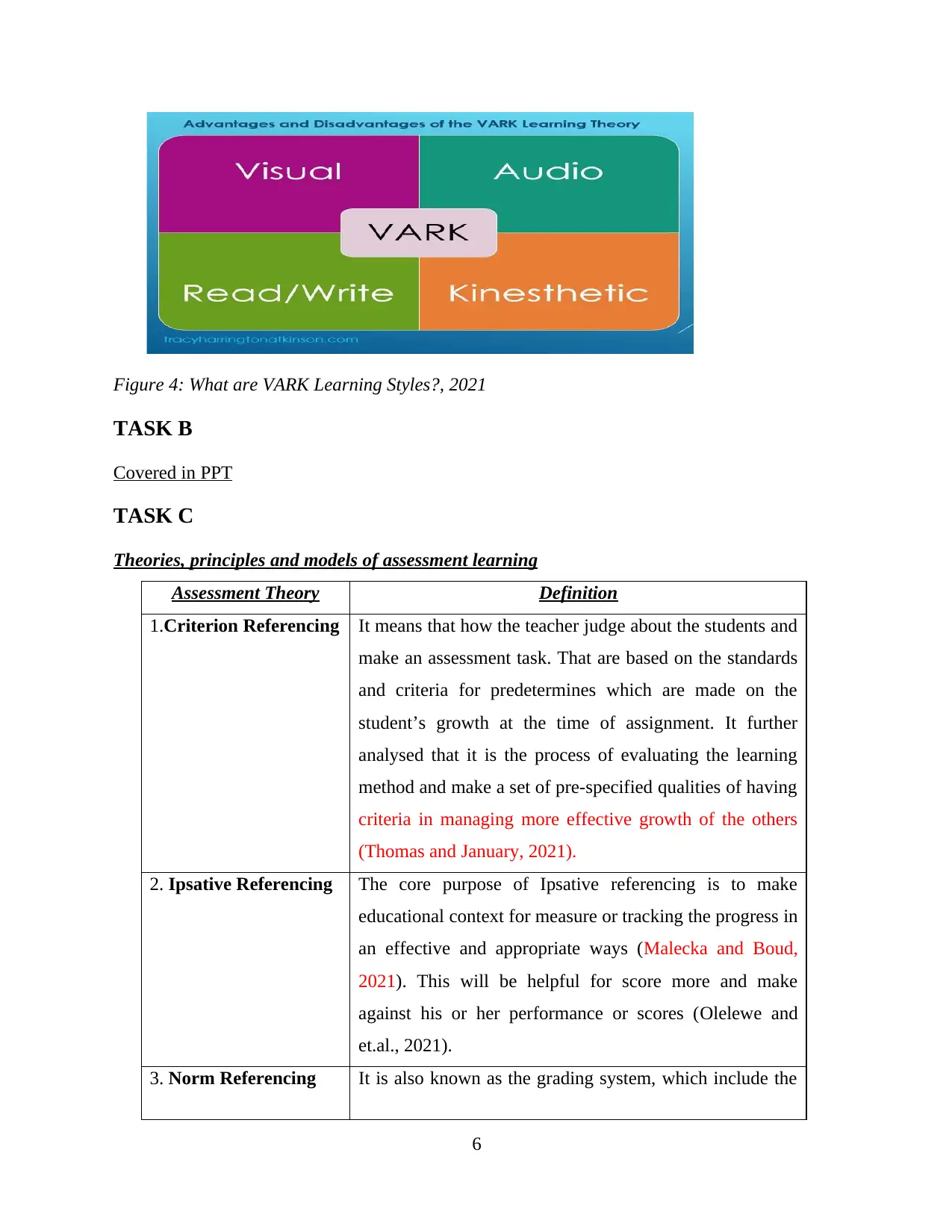
Figure 4: What are VARK Learning Styles?, 2021
TASK B
Covered in PPT
TASK C
Theories, principles and models of assessment learning
Assessment Theory Definition
1.Criterion Referencing It means that how the teacher judge about the students and
make an assessment task. That are based on the standards
and criteria for predetermines which are made on the
student’s growth at the time of assignment. It further
analysed that it is the process of evaluating the learning
method and make a set of pre-specified qualities of having
criteria in managing more effective growth of the others
(Thomas and January, 2021).
2. Ipsative Referencing The core purpose of Ipsative referencing is to make
educational context for measure or tracking the progress in
an effective and appropriate ways (Malecka and Boud,
2021). This will be helpful for score more and make
against his or her performance or scores (Olelewe and
et.al., 2021).
3. Norm Referencing It is also known as the grading system, which include the
6
TASK B
Covered in PPT
TASK C
Theories, principles and models of assessment learning
Assessment Theory Definition
1.Criterion Referencing It means that how the teacher judge about the students and
make an assessment task. That are based on the standards
and criteria for predetermines which are made on the
student’s growth at the time of assignment. It further
analysed that it is the process of evaluating the learning
method and make a set of pre-specified qualities of having
criteria in managing more effective growth of the others
(Thomas and January, 2021).
2. Ipsative Referencing The core purpose of Ipsative referencing is to make
educational context for measure or tracking the progress in
an effective and appropriate ways (Malecka and Boud,
2021). This will be helpful for score more and make
against his or her performance or scores (Olelewe and
et.al., 2021).
3. Norm Referencing It is also known as the grading system, which include the
6
⊘ This is a preview!⊘
Do you want full access?
Subscribe today to unlock all pages.

Trusted by 1+ million students worldwide
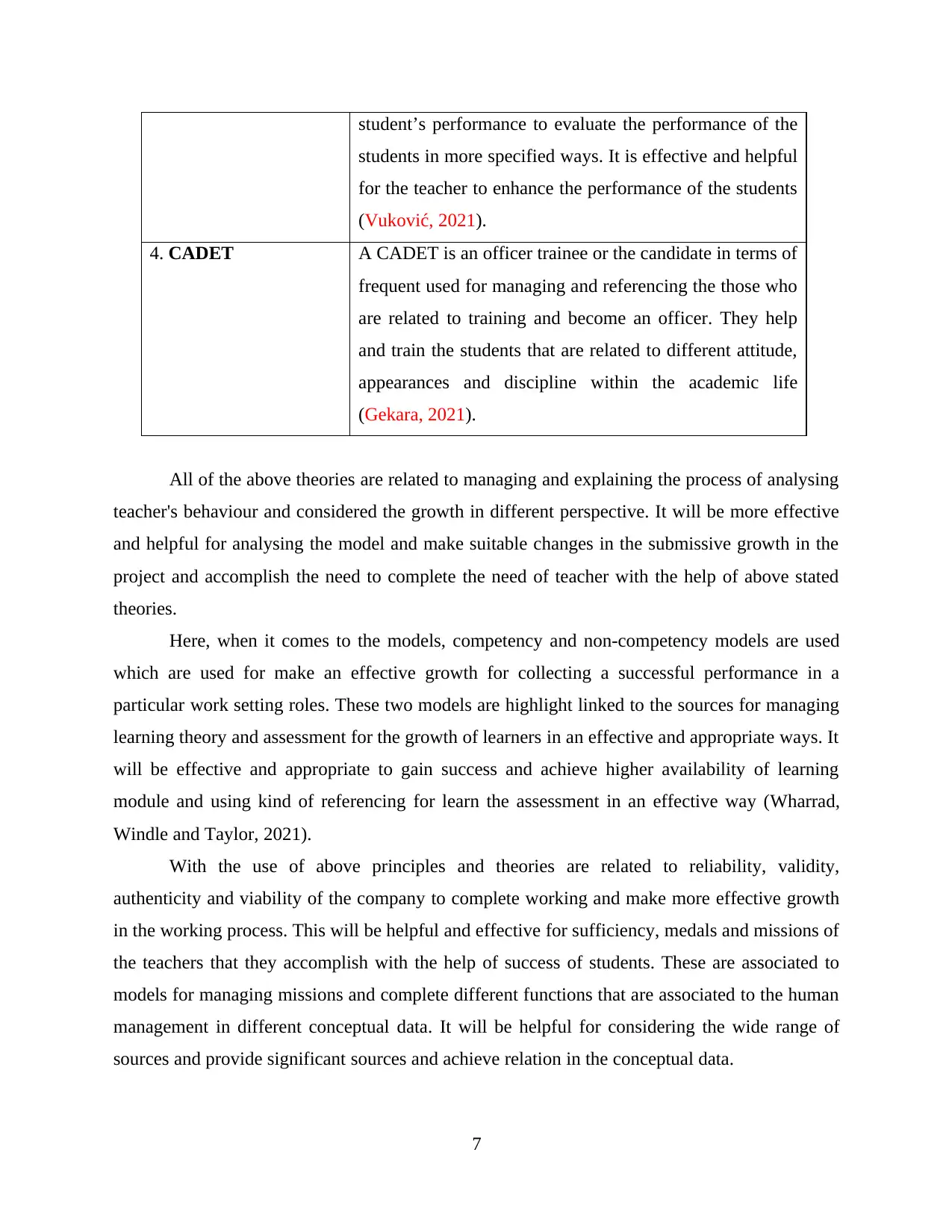
student’s performance to evaluate the performance of the
students in more specified ways. It is effective and helpful
for the teacher to enhance the performance of the students
(Vuković, 2021).
4. CADET A CADET is an officer trainee or the candidate in terms of
frequent used for managing and referencing the those who
are related to training and become an officer. They help
and train the students that are related to different attitude,
appearances and discipline within the academic life
(Gekara, 2021).
All of the above theories are related to managing and explaining the process of analysing
teacher's behaviour and considered the growth in different perspective. It will be more effective
and helpful for analysing the model and make suitable changes in the submissive growth in the
project and accomplish the need to complete the need of teacher with the help of above stated
theories.
Here, when it comes to the models, competency and non-competency models are used
which are used for make an effective growth for collecting a successful performance in a
particular work setting roles. These two models are highlight linked to the sources for managing
learning theory and assessment for the growth of learners in an effective and appropriate ways. It
will be effective and appropriate to gain success and achieve higher availability of learning
module and using kind of referencing for learn the assessment in an effective way (Wharrad,
Windle and Taylor, 2021).
With the use of above principles and theories are related to reliability, validity,
authenticity and viability of the company to complete working and make more effective growth
in the working process. This will be helpful and effective for sufficiency, medals and missions of
the teachers that they accomplish with the help of success of students. These are associated to
models for managing missions and complete different functions that are associated to the human
management in different conceptual data. It will be helpful for considering the wide range of
sources and provide significant sources and achieve relation in the conceptual data.
7
students in more specified ways. It is effective and helpful
for the teacher to enhance the performance of the students
(Vuković, 2021).
4. CADET A CADET is an officer trainee or the candidate in terms of
frequent used for managing and referencing the those who
are related to training and become an officer. They help
and train the students that are related to different attitude,
appearances and discipline within the academic life
(Gekara, 2021).
All of the above theories are related to managing and explaining the process of analysing
teacher's behaviour and considered the growth in different perspective. It will be more effective
and helpful for analysing the model and make suitable changes in the submissive growth in the
project and accomplish the need to complete the need of teacher with the help of above stated
theories.
Here, when it comes to the models, competency and non-competency models are used
which are used for make an effective growth for collecting a successful performance in a
particular work setting roles. These two models are highlight linked to the sources for managing
learning theory and assessment for the growth of learners in an effective and appropriate ways. It
will be effective and appropriate to gain success and achieve higher availability of learning
module and using kind of referencing for learn the assessment in an effective way (Wharrad,
Windle and Taylor, 2021).
With the use of above principles and theories are related to reliability, validity,
authenticity and viability of the company to complete working and make more effective growth
in the working process. This will be helpful and effective for sufficiency, medals and missions of
the teachers that they accomplish with the help of success of students. These are associated to
models for managing missions and complete different functions that are associated to the human
management in different conceptual data. It will be helpful for considering the wide range of
sources and provide significant sources and achieve relation in the conceptual data.
7
Paraphrase This Document
Need a fresh take? Get an instant paraphrase of this document with our AI Paraphraser
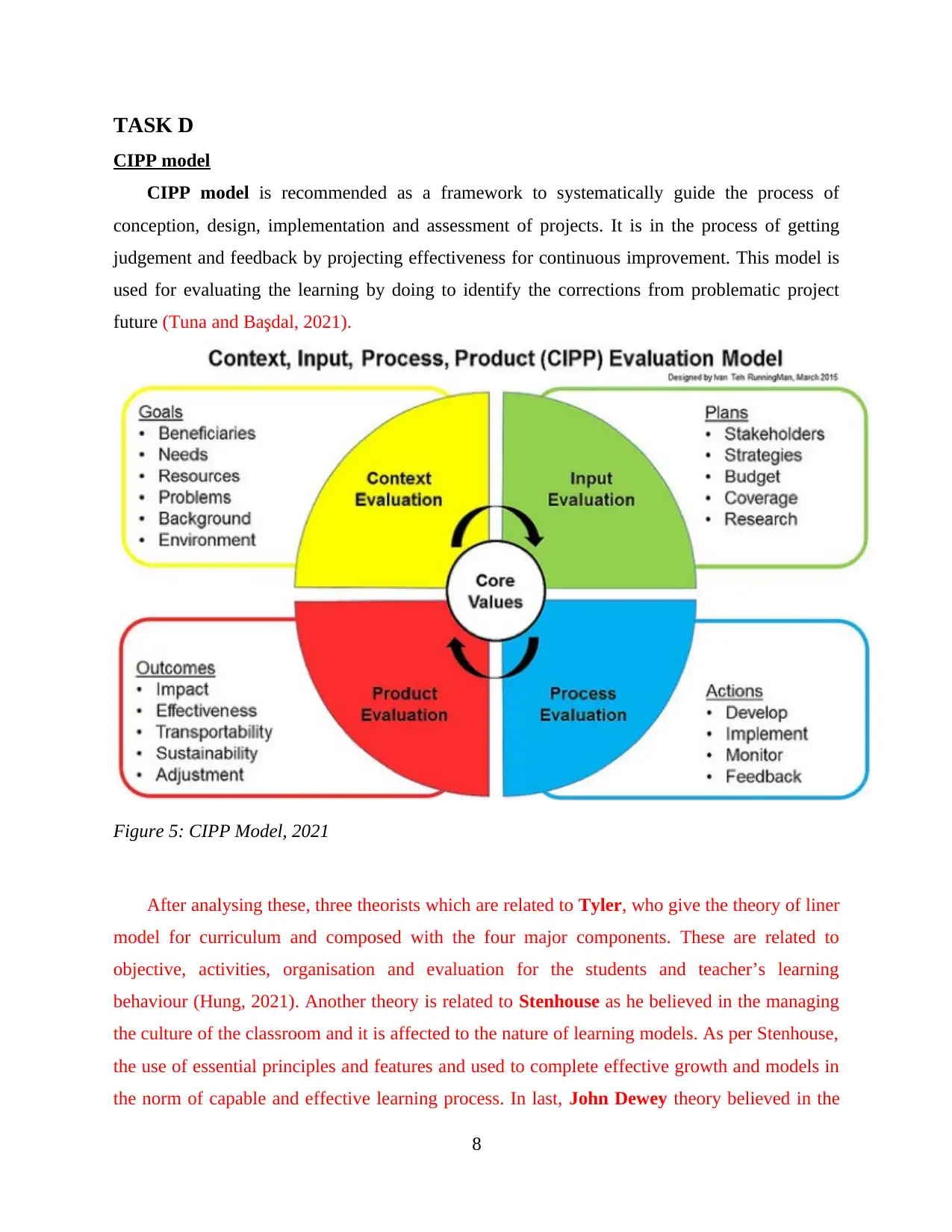
TASK D
CIPP model
CIPP model is recommended as a framework to systematically guide the process of
conception, design, implementation and assessment of projects. It is in the process of getting
judgement and feedback by projecting effectiveness for continuous improvement. This model is
used for evaluating the learning by doing to identify the corrections from problematic project
future (Tuna and Başdal, 2021).
Figure 5: CIPP Model, 2021
After analysing these, three theorists which are related to Tyler, who give the theory of liner
model for curriculum and composed with the four major components. These are related to
objective, activities, organisation and evaluation for the students and teacher’s learning
behaviour (Hung, 2021). Another theory is related to Stenhouse as he believed in the managing
the culture of the classroom and it is affected to the nature of learning models. As per Stenhouse,
the use of essential principles and features and used to complete effective growth and models in
the norm of capable and effective learning process. In last, John Dewey theory believed in the
8
CIPP model
CIPP model is recommended as a framework to systematically guide the process of
conception, design, implementation and assessment of projects. It is in the process of getting
judgement and feedback by projecting effectiveness for continuous improvement. This model is
used for evaluating the learning by doing to identify the corrections from problematic project
future (Tuna and Başdal, 2021).
Figure 5: CIPP Model, 2021
After analysing these, three theorists which are related to Tyler, who give the theory of liner
model for curriculum and composed with the four major components. These are related to
objective, activities, organisation and evaluation for the students and teacher’s learning
behaviour (Hung, 2021). Another theory is related to Stenhouse as he believed in the managing
the culture of the classroom and it is affected to the nature of learning models. As per Stenhouse,
the use of essential principles and features and used to complete effective growth and models in
the norm of capable and effective learning process. In last, John Dewey theory believed in the
8
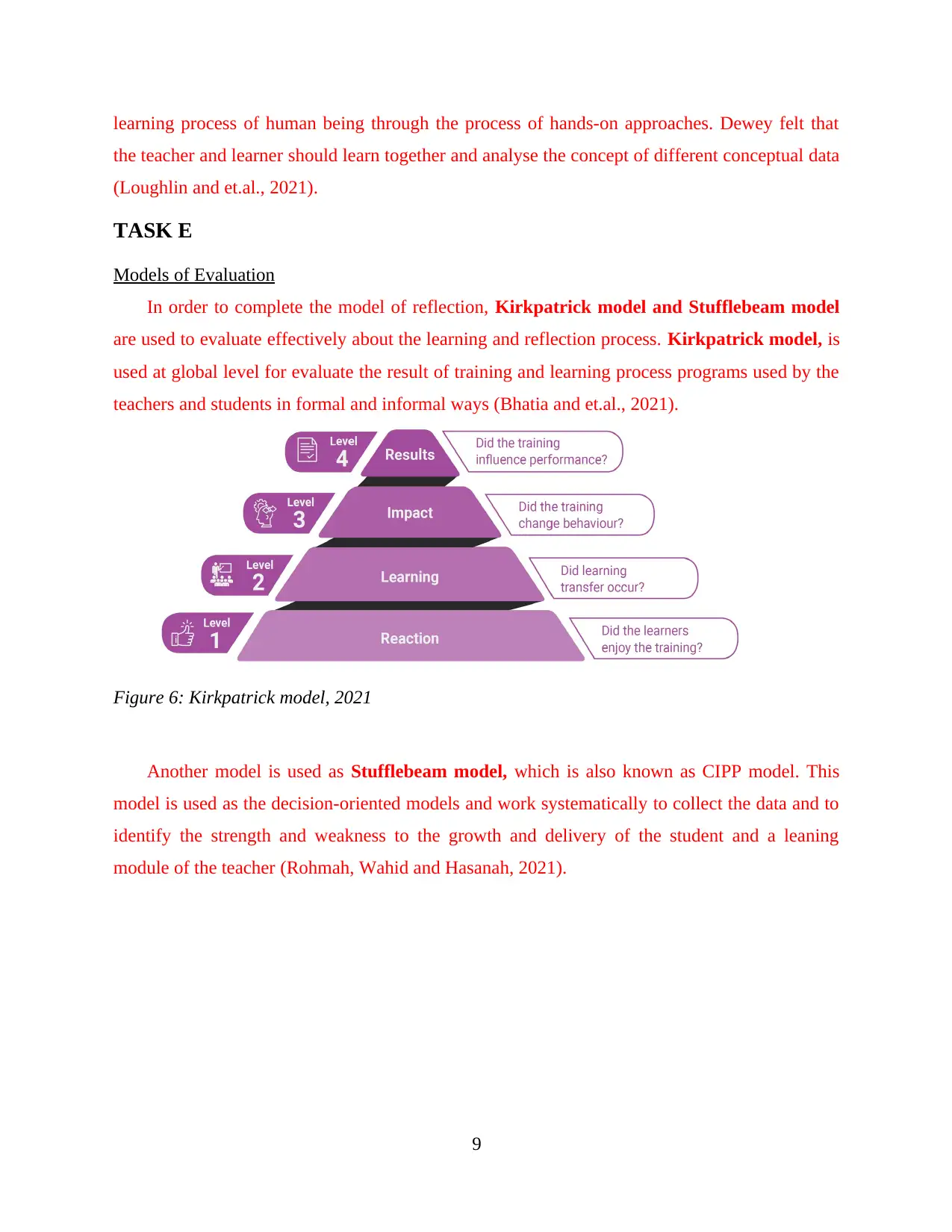
learning process of human being through the process of hands-on approaches. Dewey felt that
the teacher and learner should learn together and analyse the concept of different conceptual data
(Loughlin and et.al., 2021).
TASK E
Models of Evaluation
In order to complete the model of reflection, Kirkpatrick model and Stufflebeam model
are used to evaluate effectively about the learning and reflection process. Kirkpatrick model, is
used at global level for evaluate the result of training and learning process programs used by the
teachers and students in formal and informal ways (Bhatia and et.al., 2021).
Figure 6: Kirkpatrick model, 2021
Another model is used as Stufflebeam model, which is also known as CIPP model. This
model is used as the decision-oriented models and work systematically to collect the data and to
identify the strength and weakness to the growth and delivery of the student and a leaning
module of the teacher (Rohmah, Wahid and Hasanah, 2021).
9
the teacher and learner should learn together and analyse the concept of different conceptual data
(Loughlin and et.al., 2021).
TASK E
Models of Evaluation
In order to complete the model of reflection, Kirkpatrick model and Stufflebeam model
are used to evaluate effectively about the learning and reflection process. Kirkpatrick model, is
used at global level for evaluate the result of training and learning process programs used by the
teachers and students in formal and informal ways (Bhatia and et.al., 2021).
Figure 6: Kirkpatrick model, 2021
Another model is used as Stufflebeam model, which is also known as CIPP model. This
model is used as the decision-oriented models and work systematically to collect the data and to
identify the strength and weakness to the growth and delivery of the student and a leaning
module of the teacher (Rohmah, Wahid and Hasanah, 2021).
9
⊘ This is a preview!⊘
Do you want full access?
Subscribe today to unlock all pages.

Trusted by 1+ million students worldwide
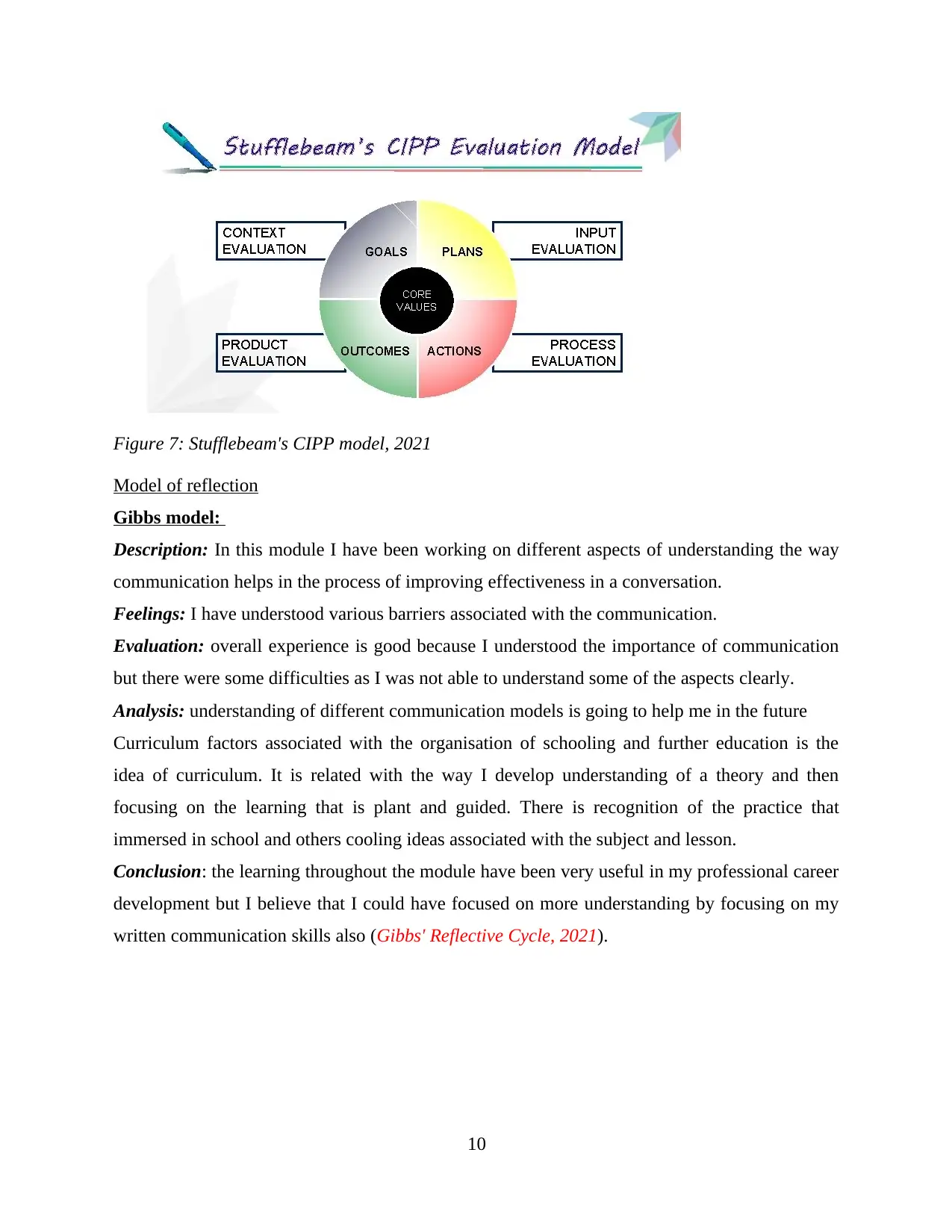
Figure 7: Stufflebeam's CIPP model, 2021
Model of reflection
Gibbs model:
Description: In this module I have been working on different aspects of understanding the way
communication helps in the process of improving effectiveness in a conversation.
Feelings: I have understood various barriers associated with the communication.
Evaluation: overall experience is good because I understood the importance of communication
but there were some difficulties as I was not able to understand some of the aspects clearly.
Analysis: understanding of different communication models is going to help me in the future
Curriculum factors associated with the organisation of schooling and further education is the
idea of curriculum. It is related with the way I develop understanding of a theory and then
focusing on the learning that is plant and guided. There is recognition of the practice that
immersed in school and others cooling ideas associated with the subject and lesson.
Conclusion: the learning throughout the module have been very useful in my professional career
development but I believe that I could have focused on more understanding by focusing on my
written communication skills also (Gibbs' Reflective Cycle, 2021).
10
Model of reflection
Gibbs model:
Description: In this module I have been working on different aspects of understanding the way
communication helps in the process of improving effectiveness in a conversation.
Feelings: I have understood various barriers associated with the communication.
Evaluation: overall experience is good because I understood the importance of communication
but there were some difficulties as I was not able to understand some of the aspects clearly.
Analysis: understanding of different communication models is going to help me in the future
Curriculum factors associated with the organisation of schooling and further education is the
idea of curriculum. It is related with the way I develop understanding of a theory and then
focusing on the learning that is plant and guided. There is recognition of the practice that
immersed in school and others cooling ideas associated with the subject and lesson.
Conclusion: the learning throughout the module have been very useful in my professional career
development but I believe that I could have focused on more understanding by focusing on my
written communication skills also (Gibbs' Reflective Cycle, 2021).
10
Paraphrase This Document
Need a fresh take? Get an instant paraphrase of this document with our AI Paraphraser
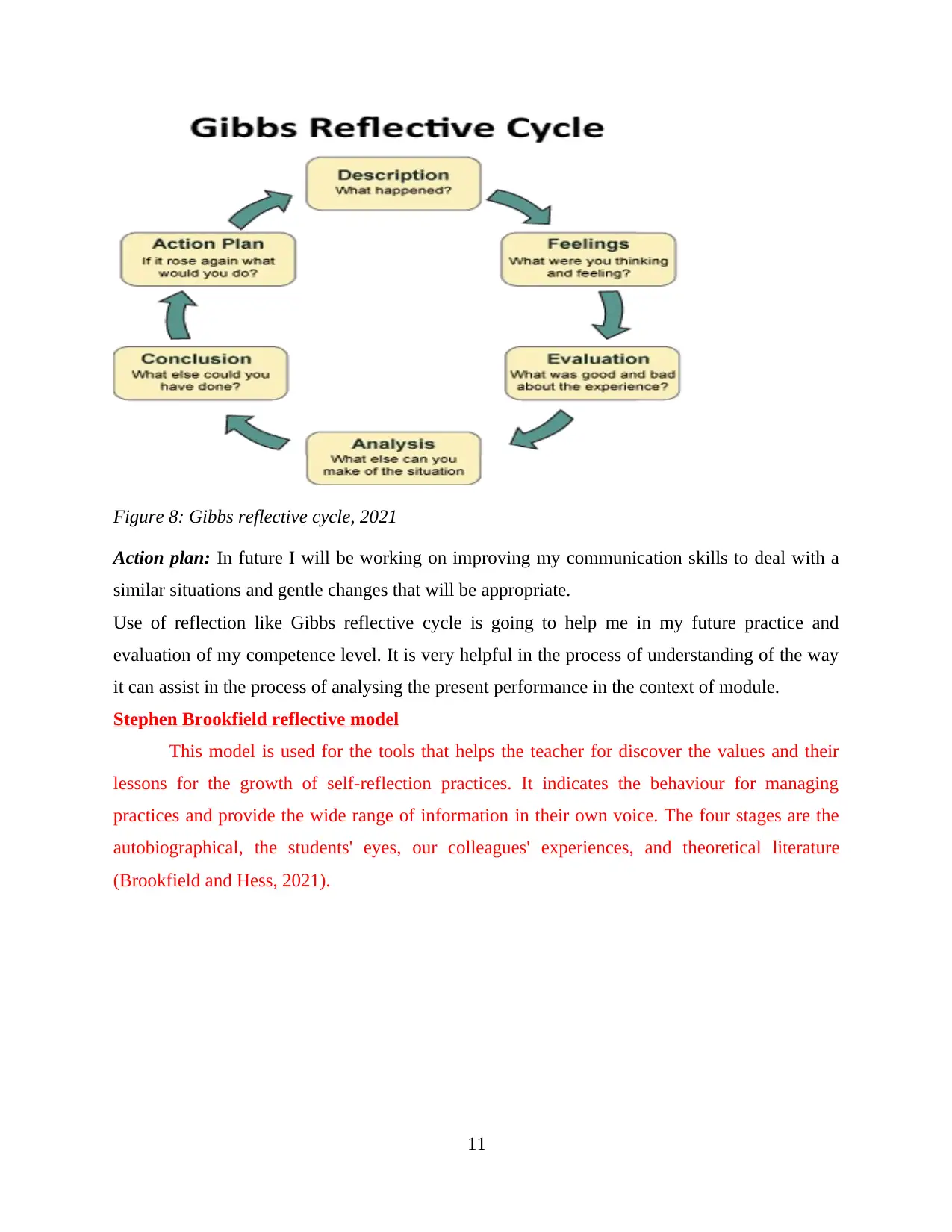
Figure 8: Gibbs reflective cycle, 2021
Action plan: In future I will be working on improving my communication skills to deal with a
similar situations and gentle changes that will be appropriate.
Use of reflection like Gibbs reflective cycle is going to help me in my future practice and
evaluation of my competence level. It is very helpful in the process of understanding of the way
it can assist in the process of analysing the present performance in the context of module.
Stephen Brookfield reflective model
This model is used for the tools that helps the teacher for discover the values and their
lessons for the growth of self-reflection practices. It indicates the behaviour for managing
practices and provide the wide range of information in their own voice. The four stages are the
autobiographical, the students' eyes, our colleagues' experiences, and theoretical literature
(Brookfield and Hess, 2021).
11
Action plan: In future I will be working on improving my communication skills to deal with a
similar situations and gentle changes that will be appropriate.
Use of reflection like Gibbs reflective cycle is going to help me in my future practice and
evaluation of my competence level. It is very helpful in the process of understanding of the way
it can assist in the process of analysing the present performance in the context of module.
Stephen Brookfield reflective model
This model is used for the tools that helps the teacher for discover the values and their
lessons for the growth of self-reflection practices. It indicates the behaviour for managing
practices and provide the wide range of information in their own voice. The four stages are the
autobiographical, the students' eyes, our colleagues' experiences, and theoretical literature
(Brookfield and Hess, 2021).
11
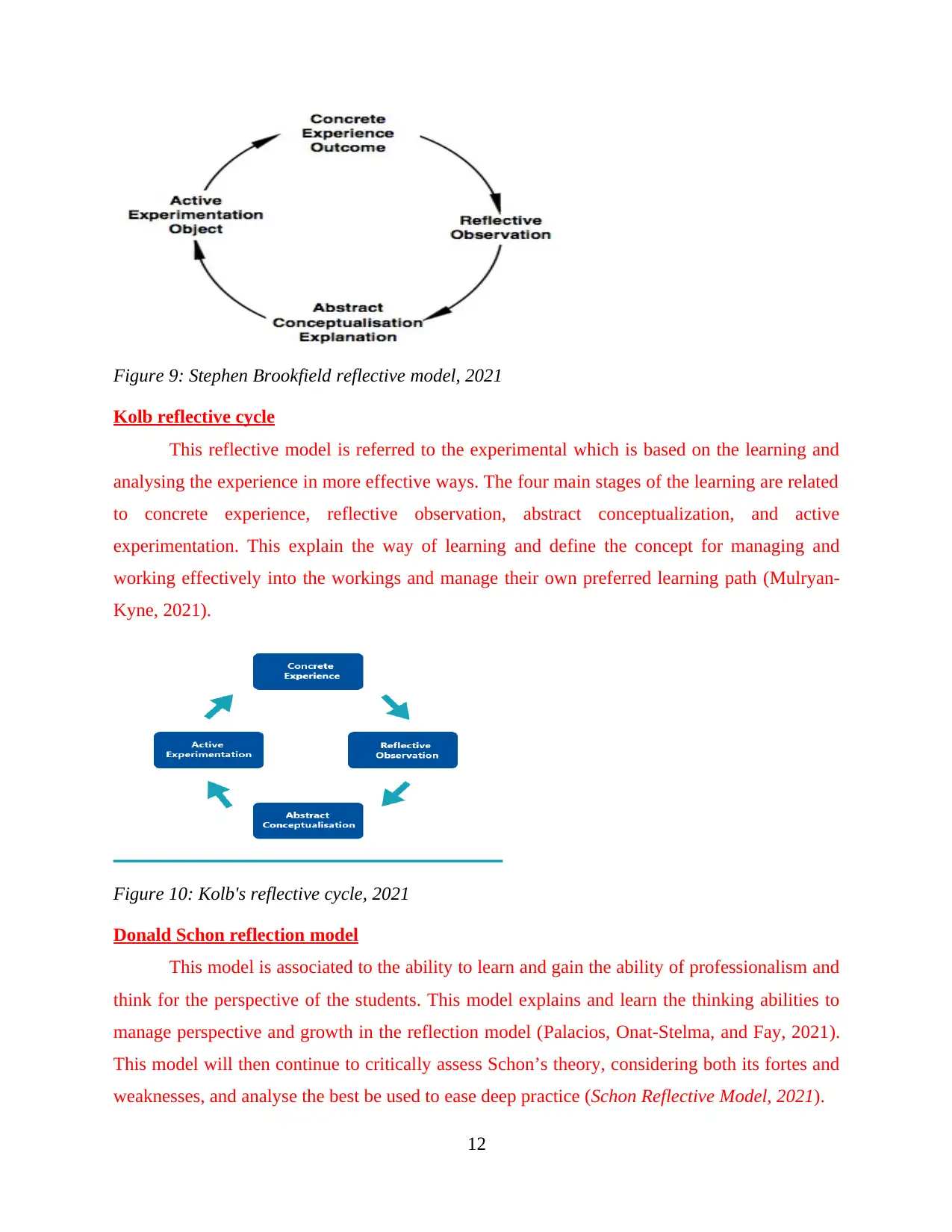
Figure 9: Stephen Brookfield reflective model, 2021
Kolb reflective cycle
This reflective model is referred to the experimental which is based on the learning and
analysing the experience in more effective ways. The four main stages of the learning are related
to concrete experience, reflective observation, abstract conceptualization, and active
experimentation. This explain the way of learning and define the concept for managing and
working effectively into the workings and manage their own preferred learning path (Mulryan-
Kyne, 2021).
Figure 10: Kolb's reflective cycle, 2021
Donald Schon reflection model
This model is associated to the ability to learn and gain the ability of professionalism and
think for the perspective of the students. This model explains and learn the thinking abilities to
manage perspective and growth in the reflection model (Palacios, Onat-Stelma, and Fay, 2021).
This model will then continue to critically assess Schon’s theory, considering both its fortes and
weaknesses, and analyse the best be used to ease deep practice (Schon Reflective Model, 2021).
12
Kolb reflective cycle
This reflective model is referred to the experimental which is based on the learning and
analysing the experience in more effective ways. The four main stages of the learning are related
to concrete experience, reflective observation, abstract conceptualization, and active
experimentation. This explain the way of learning and define the concept for managing and
working effectively into the workings and manage their own preferred learning path (Mulryan-
Kyne, 2021).
Figure 10: Kolb's reflective cycle, 2021
Donald Schon reflection model
This model is associated to the ability to learn and gain the ability of professionalism and
think for the perspective of the students. This model explains and learn the thinking abilities to
manage perspective and growth in the reflection model (Palacios, Onat-Stelma, and Fay, 2021).
This model will then continue to critically assess Schon’s theory, considering both its fortes and
weaknesses, and analyse the best be used to ease deep practice (Schon Reflective Model, 2021).
12
⊘ This is a preview!⊘
Do you want full access?
Subscribe today to unlock all pages.

Trusted by 1+ million students worldwide
1 out of 15
Related Documents
Your All-in-One AI-Powered Toolkit for Academic Success.
+13062052269
info@desklib.com
Available 24*7 on WhatsApp / Email
![[object Object]](/_next/static/media/star-bottom.7253800d.svg)
Unlock your academic potential
Copyright © 2020–2025 A2Z Services. All Rights Reserved. Developed and managed by ZUCOL.




